Financial Accounting Theories and Practice: ACCT6007 Report
VerifiedAdded on 2022/09/16
|10
|2078
|20
Report
AI Summary
This report, prepared for ACCT6007, delves into key financial accounting theories. It begins by examining the Australian Accounting Standards Board (AASB) conceptual framework, focusing on the qualitative characteristics of relevance and faithful representation. The report then explores positive accounting theory, analyzing its application in a case study of a struggling radio network and its role in financial decision-making and policy selection. Finally, it investigates public interest theory and capture theory, discussing government regulations, corporate social responsibility, and environmental disclosures. The report integrates relevant literature and provides a comprehensive overview of these crucial accounting concepts.
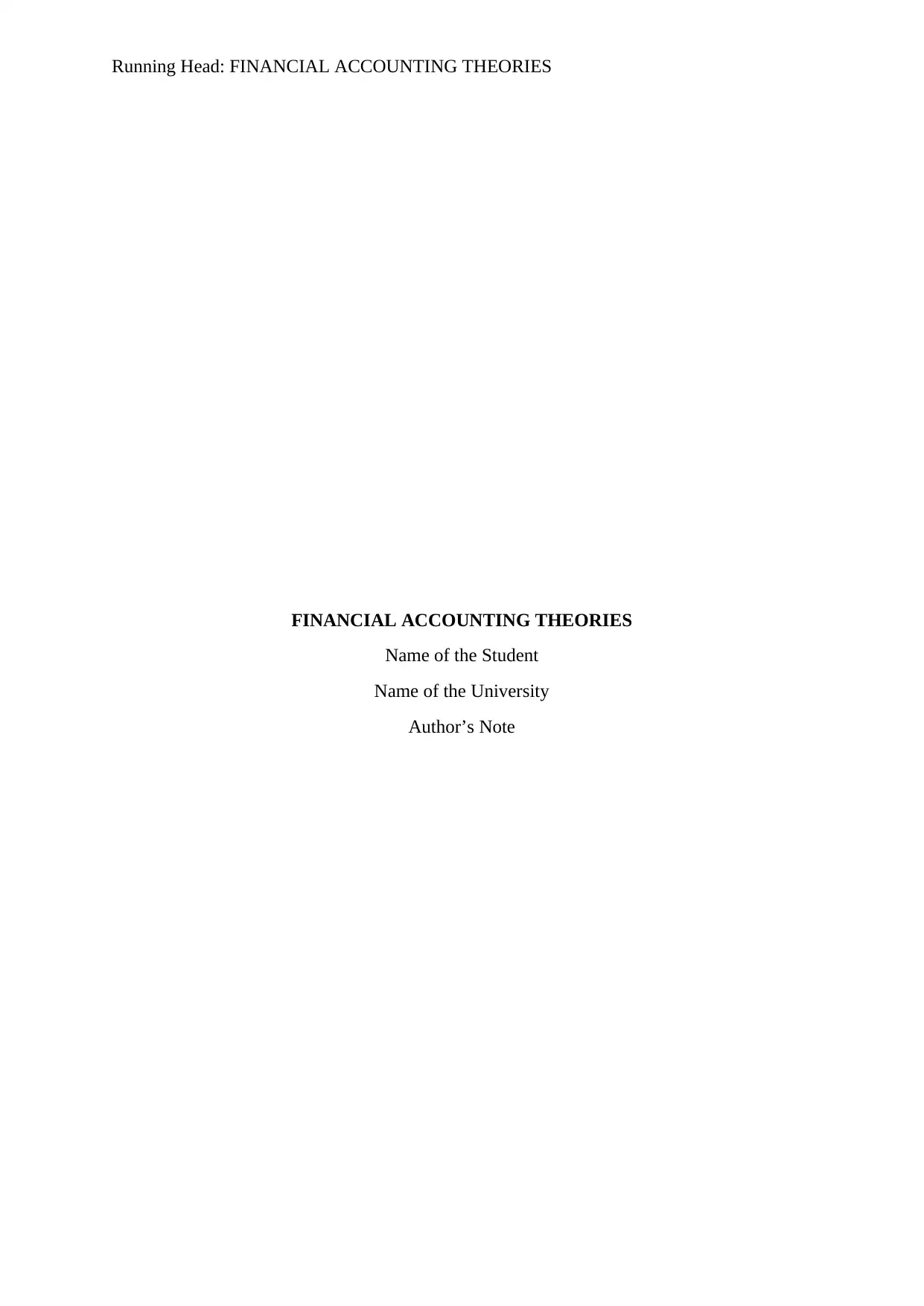
Running Head: FINANCIAL ACCOUNTING THEORIES
FINANCIAL ACCOUNTING THEORIES
Name of the Student
Name of the University
Author’s Note
FINANCIAL ACCOUNTING THEORIES
Name of the Student
Name of the University
Author’s Note
Paraphrase This Document
Need a fresh take? Get an instant paraphrase of this document with our AI Paraphraser
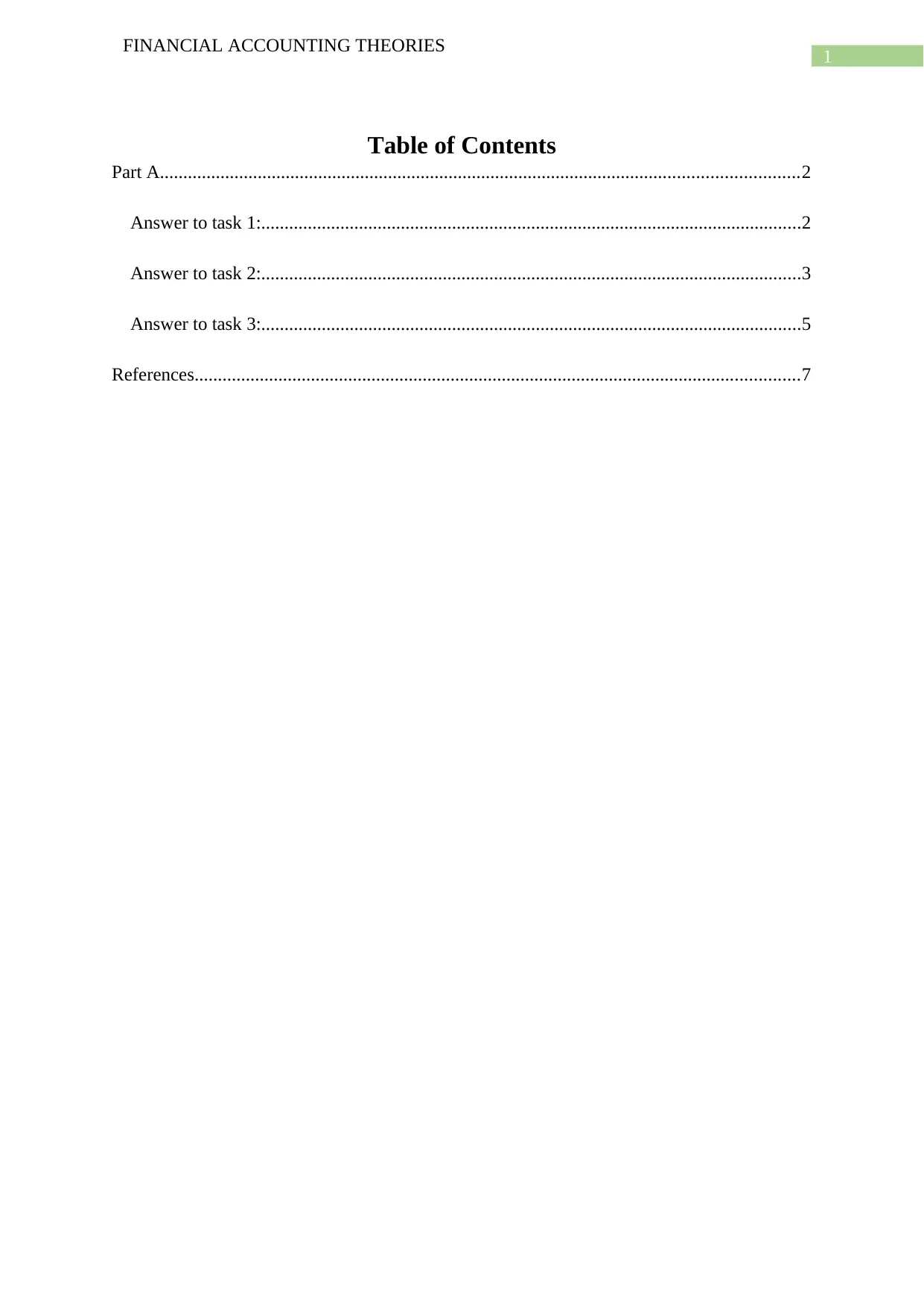
1
FINANCIAL ACCOUNTING THEORIES
Table of Contents
Part A.........................................................................................................................................2
Answer to task 1:....................................................................................................................2
Answer to task 2:....................................................................................................................3
Answer to task 3:....................................................................................................................5
References..................................................................................................................................7
FINANCIAL ACCOUNTING THEORIES
Table of Contents
Part A.........................................................................................................................................2
Answer to task 1:....................................................................................................................2
Answer to task 2:....................................................................................................................3
Answer to task 3:....................................................................................................................5
References..................................................................................................................................7
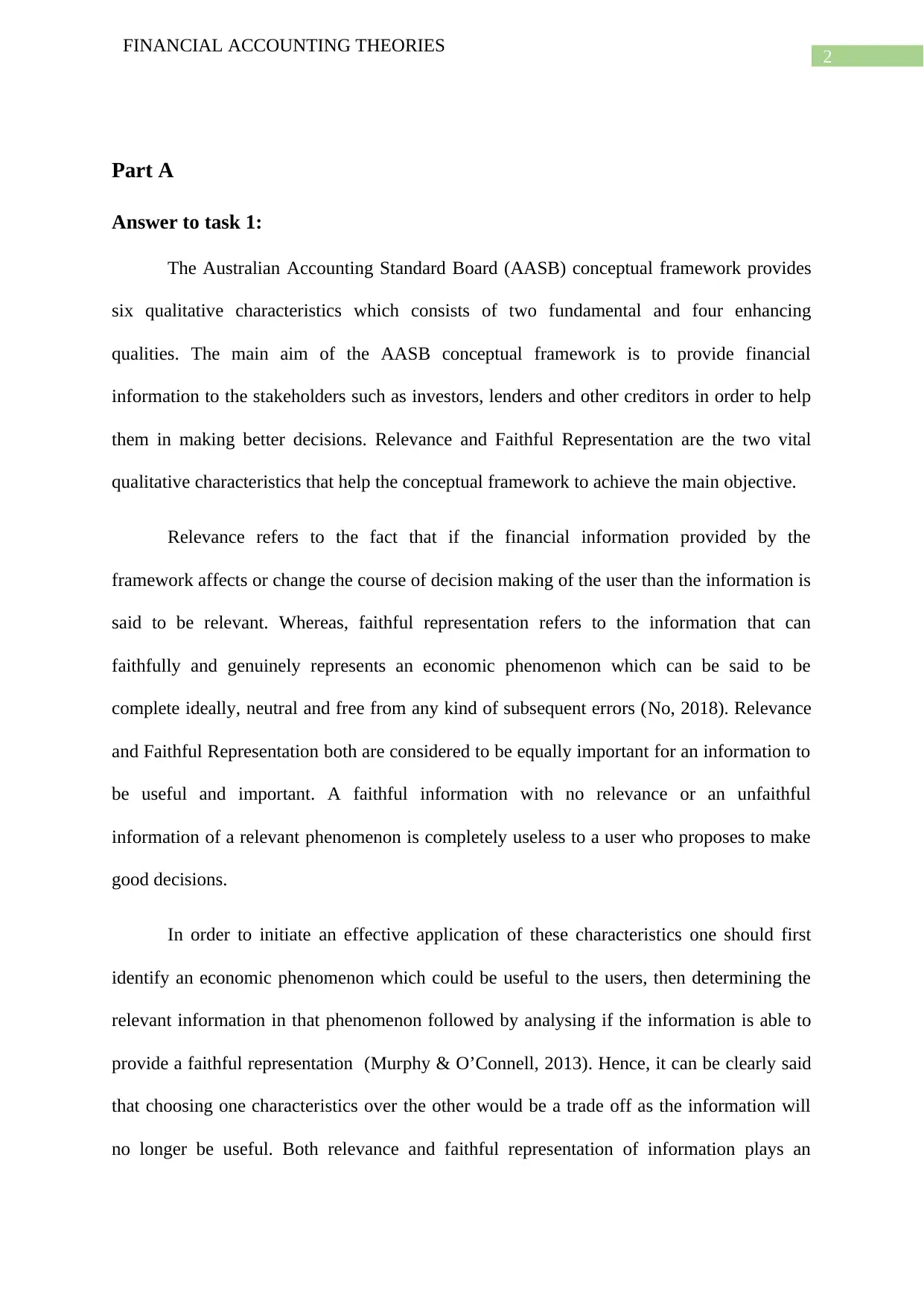
2
FINANCIAL ACCOUNTING THEORIES
Part A
Answer to task 1:
The Australian Accounting Standard Board (AASB) conceptual framework provides
six qualitative characteristics which consists of two fundamental and four enhancing
qualities. The main aim of the AASB conceptual framework is to provide financial
information to the stakeholders such as investors, lenders and other creditors in order to help
them in making better decisions. Relevance and Faithful Representation are the two vital
qualitative characteristics that help the conceptual framework to achieve the main objective.
Relevance refers to the fact that if the financial information provided by the
framework affects or change the course of decision making of the user than the information is
said to be relevant. Whereas, faithful representation refers to the information that can
faithfully and genuinely represents an economic phenomenon which can be said to be
complete ideally, neutral and free from any kind of subsequent errors (No, 2018). Relevance
and Faithful Representation both are considered to be equally important for an information to
be useful and important. A faithful information with no relevance or an unfaithful
information of a relevant phenomenon is completely useless to a user who proposes to make
good decisions.
In order to initiate an effective application of these characteristics one should first
identify an economic phenomenon which could be useful to the users, then determining the
relevant information in that phenomenon followed by analysing if the information is able to
provide a faithful representation (Murphy & O’Connell, 2013). Hence, it can be clearly said
that choosing one characteristics over the other would be a trade off as the information will
no longer be useful. Both relevance and faithful representation of information plays an
FINANCIAL ACCOUNTING THEORIES
Part A
Answer to task 1:
The Australian Accounting Standard Board (AASB) conceptual framework provides
six qualitative characteristics which consists of two fundamental and four enhancing
qualities. The main aim of the AASB conceptual framework is to provide financial
information to the stakeholders such as investors, lenders and other creditors in order to help
them in making better decisions. Relevance and Faithful Representation are the two vital
qualitative characteristics that help the conceptual framework to achieve the main objective.
Relevance refers to the fact that if the financial information provided by the
framework affects or change the course of decision making of the user than the information is
said to be relevant. Whereas, faithful representation refers to the information that can
faithfully and genuinely represents an economic phenomenon which can be said to be
complete ideally, neutral and free from any kind of subsequent errors (No, 2018). Relevance
and Faithful Representation both are considered to be equally important for an information to
be useful and important. A faithful information with no relevance or an unfaithful
information of a relevant phenomenon is completely useless to a user who proposes to make
good decisions.
In order to initiate an effective application of these characteristics one should first
identify an economic phenomenon which could be useful to the users, then determining the
relevant information in that phenomenon followed by analysing if the information is able to
provide a faithful representation (Murphy & O’Connell, 2013). Hence, it can be clearly said
that choosing one characteristics over the other would be a trade off as the information will
no longer be useful. Both relevance and faithful representation of information plays an
⊘ This is a preview!⊘
Do you want full access?
Subscribe today to unlock all pages.

Trusted by 1+ million students worldwide
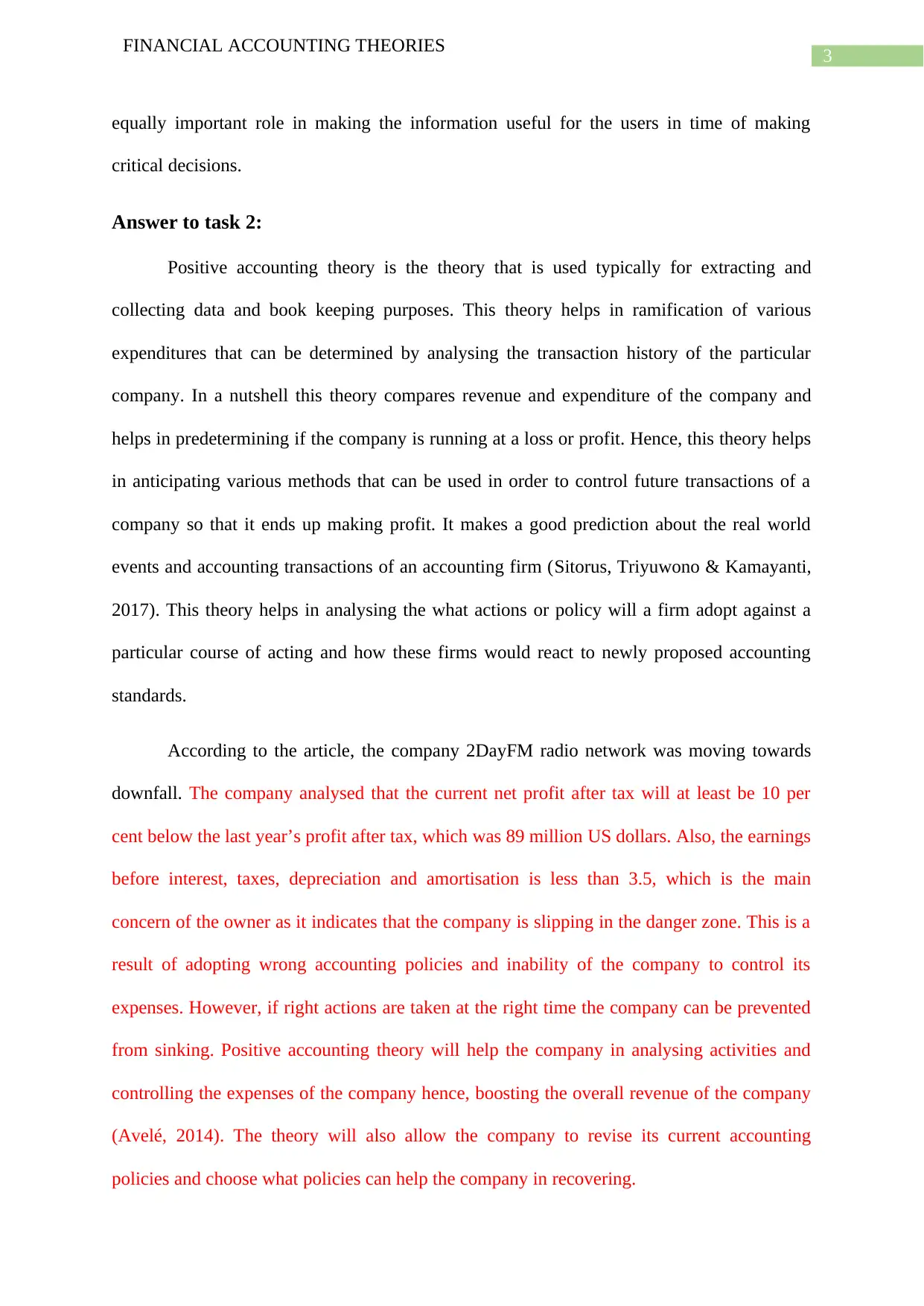
3
FINANCIAL ACCOUNTING THEORIES
equally important role in making the information useful for the users in time of making
critical decisions.
Answer to task 2:
Positive accounting theory is the theory that is used typically for extracting and
collecting data and book keeping purposes. This theory helps in ramification of various
expenditures that can be determined by analysing the transaction history of the particular
company. In a nutshell this theory compares revenue and expenditure of the company and
helps in predetermining if the company is running at a loss or profit. Hence, this theory helps
in anticipating various methods that can be used in order to control future transactions of a
company so that it ends up making profit. It makes a good prediction about the real world
events and accounting transactions of an accounting firm (Sitorus, Triyuwono & Kamayanti,
2017). This theory helps in analysing the what actions or policy will a firm adopt against a
particular course of acting and how these firms would react to newly proposed accounting
standards.
According to the article, the company 2DayFM radio network was moving towards
downfall. The company analysed that the current net profit after tax will at least be 10 per
cent below the last year’s profit after tax, which was 89 million US dollars. Also, the earnings
before interest, taxes, depreciation and amortisation is less than 3.5, which is the main
concern of the owner as it indicates that the company is slipping in the danger zone. This is a
result of adopting wrong accounting policies and inability of the company to control its
expenses. However, if right actions are taken at the right time the company can be prevented
from sinking. Positive accounting theory will help the company in analysing activities and
controlling the expenses of the company hence, boosting the overall revenue of the company
(Avelé, 2014). The theory will also allow the company to revise its current accounting
policies and choose what policies can help the company in recovering.
FINANCIAL ACCOUNTING THEORIES
equally important role in making the information useful for the users in time of making
critical decisions.
Answer to task 2:
Positive accounting theory is the theory that is used typically for extracting and
collecting data and book keeping purposes. This theory helps in ramification of various
expenditures that can be determined by analysing the transaction history of the particular
company. In a nutshell this theory compares revenue and expenditure of the company and
helps in predetermining if the company is running at a loss or profit. Hence, this theory helps
in anticipating various methods that can be used in order to control future transactions of a
company so that it ends up making profit. It makes a good prediction about the real world
events and accounting transactions of an accounting firm (Sitorus, Triyuwono & Kamayanti,
2017). This theory helps in analysing the what actions or policy will a firm adopt against a
particular course of acting and how these firms would react to newly proposed accounting
standards.
According to the article, the company 2DayFM radio network was moving towards
downfall. The company analysed that the current net profit after tax will at least be 10 per
cent below the last year’s profit after tax, which was 89 million US dollars. Also, the earnings
before interest, taxes, depreciation and amortisation is less than 3.5, which is the main
concern of the owner as it indicates that the company is slipping in the danger zone. This is a
result of adopting wrong accounting policies and inability of the company to control its
expenses. However, if right actions are taken at the right time the company can be prevented
from sinking. Positive accounting theory will help the company in analysing activities and
controlling the expenses of the company hence, boosting the overall revenue of the company
(Avelé, 2014). The theory will also allow the company to revise its current accounting
policies and choose what policies can help the company in recovering.
Paraphrase This Document
Need a fresh take? Get an instant paraphrase of this document with our AI Paraphraser
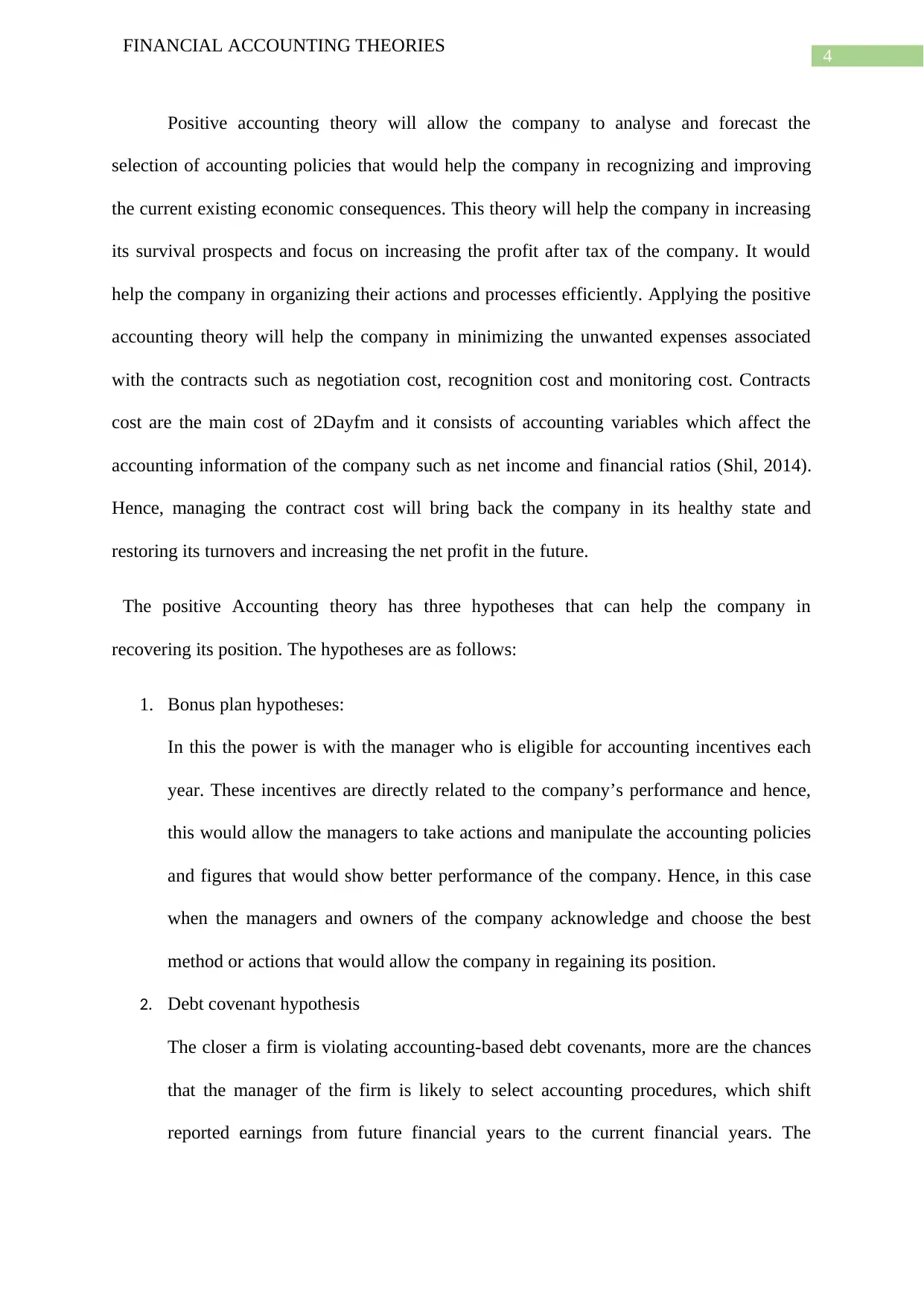
4
FINANCIAL ACCOUNTING THEORIES
Positive accounting theory will allow the company to analyse and forecast the
selection of accounting policies that would help the company in recognizing and improving
the current existing economic consequences. This theory will help the company in increasing
its survival prospects and focus on increasing the profit after tax of the company. It would
help the company in organizing their actions and processes efficiently. Applying the positive
accounting theory will help the company in minimizing the unwanted expenses associated
with the contracts such as negotiation cost, recognition cost and monitoring cost. Contracts
cost are the main cost of 2Dayfm and it consists of accounting variables which affect the
accounting information of the company such as net income and financial ratios (Shil, 2014).
Hence, managing the contract cost will bring back the company in its healthy state and
restoring its turnovers and increasing the net profit in the future.
The positive Accounting theory has three hypotheses that can help the company in
recovering its position. The hypotheses are as follows:
1. Bonus plan hypotheses:
In this the power is with the manager who is eligible for accounting incentives each
year. These incentives are directly related to the company’s performance and hence,
this would allow the managers to take actions and manipulate the accounting policies
and figures that would show better performance of the company. Hence, in this case
when the managers and owners of the company acknowledge and choose the best
method or actions that would allow the company in regaining its position.
2. Debt covenant hypothesis
The closer a firm is violating accounting-based debt covenants, more are the chances
that the manager of the firm is likely to select accounting procedures, which shift
reported earnings from future financial years to the current financial years. The
FINANCIAL ACCOUNTING THEORIES
Positive accounting theory will allow the company to analyse and forecast the
selection of accounting policies that would help the company in recognizing and improving
the current existing economic consequences. This theory will help the company in increasing
its survival prospects and focus on increasing the profit after tax of the company. It would
help the company in organizing their actions and processes efficiently. Applying the positive
accounting theory will help the company in minimizing the unwanted expenses associated
with the contracts such as negotiation cost, recognition cost and monitoring cost. Contracts
cost are the main cost of 2Dayfm and it consists of accounting variables which affect the
accounting information of the company such as net income and financial ratios (Shil, 2014).
Hence, managing the contract cost will bring back the company in its healthy state and
restoring its turnovers and increasing the net profit in the future.
The positive Accounting theory has three hypotheses that can help the company in
recovering its position. The hypotheses are as follows:
1. Bonus plan hypotheses:
In this the power is with the manager who is eligible for accounting incentives each
year. These incentives are directly related to the company’s performance and hence,
this would allow the managers to take actions and manipulate the accounting policies
and figures that would show better performance of the company. Hence, in this case
when the managers and owners of the company acknowledge and choose the best
method or actions that would allow the company in regaining its position.
2. Debt covenant hypothesis
The closer a firm is violating accounting-based debt covenants, more are the chances
that the manager of the firm is likely to select accounting procedures, which shift
reported earnings from future financial years to the current financial years. The
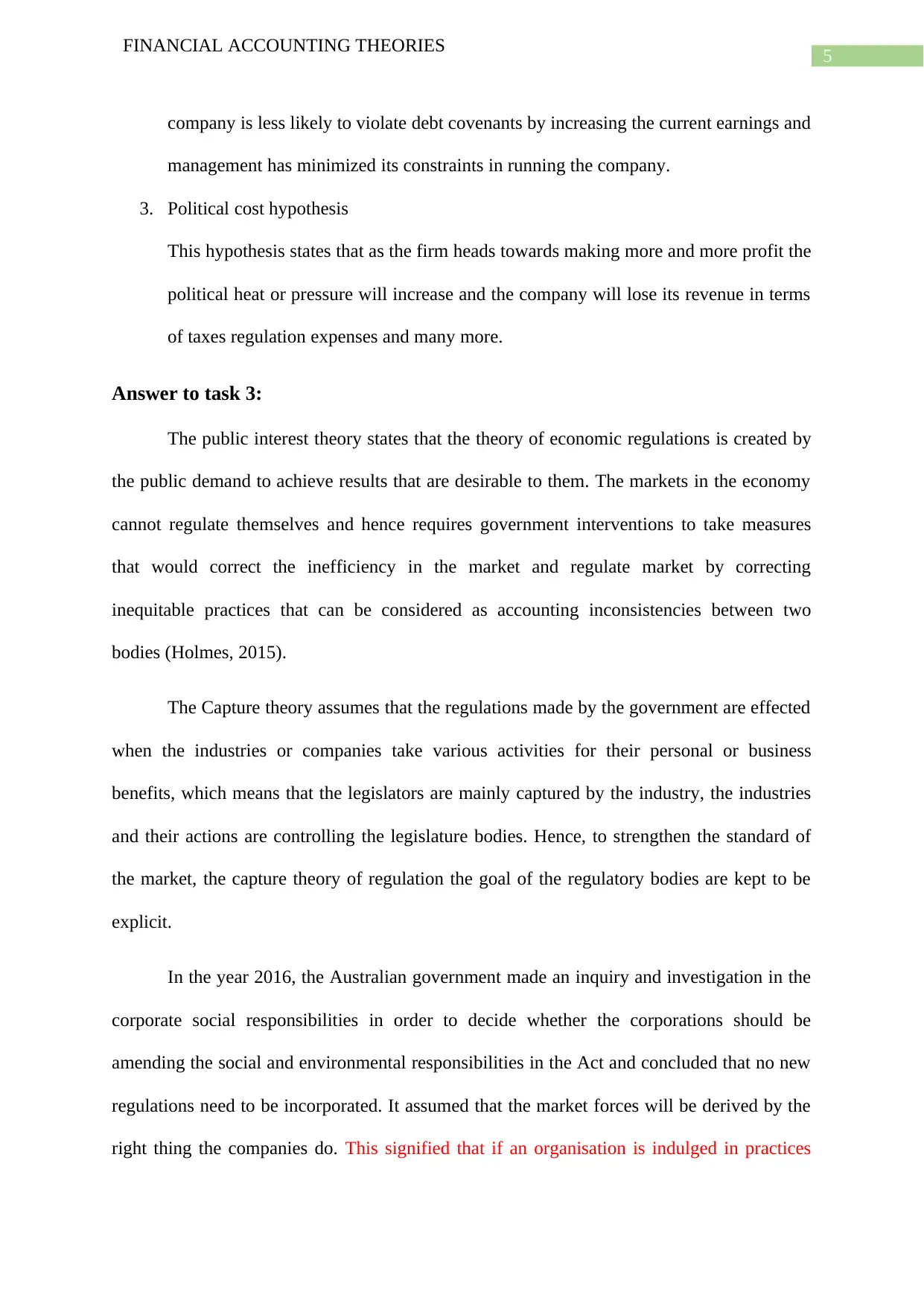
5
FINANCIAL ACCOUNTING THEORIES
company is less likely to violate debt covenants by increasing the current earnings and
management has minimized its constraints in running the company.
3. Political cost hypothesis
This hypothesis states that as the firm heads towards making more and more profit the
political heat or pressure will increase and the company will lose its revenue in terms
of taxes regulation expenses and many more.
Answer to task 3:
The public interest theory states that the theory of economic regulations is created by
the public demand to achieve results that are desirable to them. The markets in the economy
cannot regulate themselves and hence requires government interventions to take measures
that would correct the inefficiency in the market and regulate market by correcting
inequitable practices that can be considered as accounting inconsistencies between two
bodies (Holmes, 2015).
The Capture theory assumes that the regulations made by the government are effected
when the industries or companies take various activities for their personal or business
benefits, which means that the legislators are mainly captured by the industry, the industries
and their actions are controlling the legislature bodies. Hence, to strengthen the standard of
the market, the capture theory of regulation the goal of the regulatory bodies are kept to be
explicit.
In the year 2016, the Australian government made an inquiry and investigation in the
corporate social responsibilities in order to decide whether the corporations should be
amending the social and environmental responsibilities in the Act and concluded that no new
regulations need to be incorporated. It assumed that the market forces will be derived by the
right thing the companies do. This signified that if an organisation is indulged in practices
FINANCIAL ACCOUNTING THEORIES
company is less likely to violate debt covenants by increasing the current earnings and
management has minimized its constraints in running the company.
3. Political cost hypothesis
This hypothesis states that as the firm heads towards making more and more profit the
political heat or pressure will increase and the company will lose its revenue in terms
of taxes regulation expenses and many more.
Answer to task 3:
The public interest theory states that the theory of economic regulations is created by
the public demand to achieve results that are desirable to them. The markets in the economy
cannot regulate themselves and hence requires government interventions to take measures
that would correct the inefficiency in the market and regulate market by correcting
inequitable practices that can be considered as accounting inconsistencies between two
bodies (Holmes, 2015).
The Capture theory assumes that the regulations made by the government are effected
when the industries or companies take various activities for their personal or business
benefits, which means that the legislators are mainly captured by the industry, the industries
and their actions are controlling the legislature bodies. Hence, to strengthen the standard of
the market, the capture theory of regulation the goal of the regulatory bodies are kept to be
explicit.
In the year 2016, the Australian government made an inquiry and investigation in the
corporate social responsibilities in order to decide whether the corporations should be
amending the social and environmental responsibilities in the Act and concluded that no new
regulations need to be incorporated. It assumed that the market forces will be derived by the
right thing the companies do. This signified that if an organisation is indulged in practices
⊘ This is a preview!⊘
Do you want full access?
Subscribe today to unlock all pages.

Trusted by 1+ million students worldwide
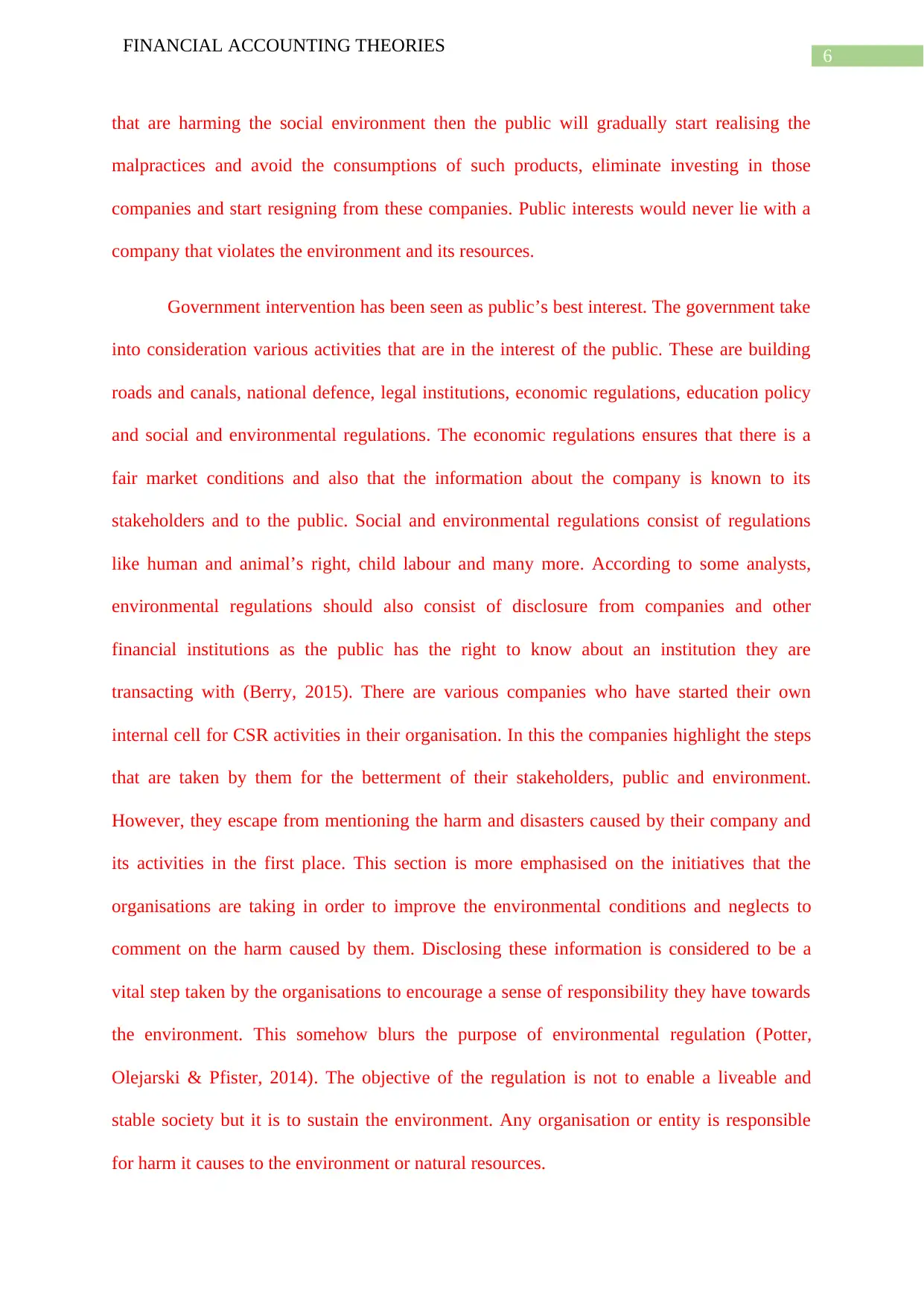
6
FINANCIAL ACCOUNTING THEORIES
that are harming the social environment then the public will gradually start realising the
malpractices and avoid the consumptions of such products, eliminate investing in those
companies and start resigning from these companies. Public interests would never lie with a
company that violates the environment and its resources.
Government intervention has been seen as public’s best interest. The government take
into consideration various activities that are in the interest of the public. These are building
roads and canals, national defence, legal institutions, economic regulations, education policy
and social and environmental regulations. The economic regulations ensures that there is a
fair market conditions and also that the information about the company is known to its
stakeholders and to the public. Social and environmental regulations consist of regulations
like human and animal’s right, child labour and many more. According to some analysts,
environmental regulations should also consist of disclosure from companies and other
financial institutions as the public has the right to know about an institution they are
transacting with (Berry, 2015). There are various companies who have started their own
internal cell for CSR activities in their organisation. In this the companies highlight the steps
that are taken by them for the betterment of their stakeholders, public and environment.
However, they escape from mentioning the harm and disasters caused by their company and
its activities in the first place. This section is more emphasised on the initiatives that the
organisations are taking in order to improve the environmental conditions and neglects to
comment on the harm caused by them. Disclosing these information is considered to be a
vital step taken by the organisations to encourage a sense of responsibility they have towards
the environment. This somehow blurs the purpose of environmental regulation (Potter,
Olejarski & Pfister, 2014). The objective of the regulation is not to enable a liveable and
stable society but it is to sustain the environment. Any organisation or entity is responsible
for harm it causes to the environment or natural resources.
FINANCIAL ACCOUNTING THEORIES
that are harming the social environment then the public will gradually start realising the
malpractices and avoid the consumptions of such products, eliminate investing in those
companies and start resigning from these companies. Public interests would never lie with a
company that violates the environment and its resources.
Government intervention has been seen as public’s best interest. The government take
into consideration various activities that are in the interest of the public. These are building
roads and canals, national defence, legal institutions, economic regulations, education policy
and social and environmental regulations. The economic regulations ensures that there is a
fair market conditions and also that the information about the company is known to its
stakeholders and to the public. Social and environmental regulations consist of regulations
like human and animal’s right, child labour and many more. According to some analysts,
environmental regulations should also consist of disclosure from companies and other
financial institutions as the public has the right to know about an institution they are
transacting with (Berry, 2015). There are various companies who have started their own
internal cell for CSR activities in their organisation. In this the companies highlight the steps
that are taken by them for the betterment of their stakeholders, public and environment.
However, they escape from mentioning the harm and disasters caused by their company and
its activities in the first place. This section is more emphasised on the initiatives that the
organisations are taking in order to improve the environmental conditions and neglects to
comment on the harm caused by them. Disclosing these information is considered to be a
vital step taken by the organisations to encourage a sense of responsibility they have towards
the environment. This somehow blurs the purpose of environmental regulation (Potter,
Olejarski & Pfister, 2014). The objective of the regulation is not to enable a liveable and
stable society but it is to sustain the environment. Any organisation or entity is responsible
for harm it causes to the environment or natural resources.
Paraphrase This Document
Need a fresh take? Get an instant paraphrase of this document with our AI Paraphraser

7
FINANCIAL ACCOUNTING THEORIES
FINANCIAL ACCOUNTING THEORIES

8
FINANCIAL ACCOUNTING THEORIES
References
Alayemi, S. A., & Abdul-Lateef, M. O. (2017). Accounting Numbers and Management’s
Financial Reporting Incentives: Evidence from Positive Accounting Theory. Noble
International Journal of Economics and Financial Research, 2(2), 50-53.
Avelé, D. (2014). Positive accounting theory: theoretical and critical
perspectives. International Journal of Critical Accounting, 6(4), 396-415.
Baker, C. R. (2017). The influence of accounting theory on the FASB conceptual
framework. Accounting Historians Journal, 44(2), 109-124.
Berry, J. M. (2015). Lobbying for the people: The political behavior of public interest groups.
Princeton University Press.
Holmes, J. E. (2015). The mood/interest theory of American foreign policy. University Press
of Kentucky.
Murphy, T., & O’Connell, V. (2013). Discourses surrounding the evolution of the
IASB/FASB Conceptual Framework: What they reveal about the “living law” of
accounting. Accounting, Organizations and Society, 38(1), 72-91.
No, A. S. (2018). Conceptual framework for financial reporting. Norwalk, CT: FASB.
Potter, M. R., Olejarski, A. M., & Pfister, S. M. (2014). Capture theory and the public
interest: Balancing competing values to ensure regulatory effectiveness. International
Journal of Public Administration, 37(10), 638-645.
Sharma, N. (2013). Theoretical framework for corporate disclosure research. Asian Journal
of Finance & Accounting, 5(1), 183.
FINANCIAL ACCOUNTING THEORIES
References
Alayemi, S. A., & Abdul-Lateef, M. O. (2017). Accounting Numbers and Management’s
Financial Reporting Incentives: Evidence from Positive Accounting Theory. Noble
International Journal of Economics and Financial Research, 2(2), 50-53.
Avelé, D. (2014). Positive accounting theory: theoretical and critical
perspectives. International Journal of Critical Accounting, 6(4), 396-415.
Baker, C. R. (2017). The influence of accounting theory on the FASB conceptual
framework. Accounting Historians Journal, 44(2), 109-124.
Berry, J. M. (2015). Lobbying for the people: The political behavior of public interest groups.
Princeton University Press.
Holmes, J. E. (2015). The mood/interest theory of American foreign policy. University Press
of Kentucky.
Murphy, T., & O’Connell, V. (2013). Discourses surrounding the evolution of the
IASB/FASB Conceptual Framework: What they reveal about the “living law” of
accounting. Accounting, Organizations and Society, 38(1), 72-91.
No, A. S. (2018). Conceptual framework for financial reporting. Norwalk, CT: FASB.
Potter, M. R., Olejarski, A. M., & Pfister, S. M. (2014). Capture theory and the public
interest: Balancing competing values to ensure regulatory effectiveness. International
Journal of Public Administration, 37(10), 638-645.
Sharma, N. (2013). Theoretical framework for corporate disclosure research. Asian Journal
of Finance & Accounting, 5(1), 183.
⊘ This is a preview!⊘
Do you want full access?
Subscribe today to unlock all pages.

Trusted by 1+ million students worldwide
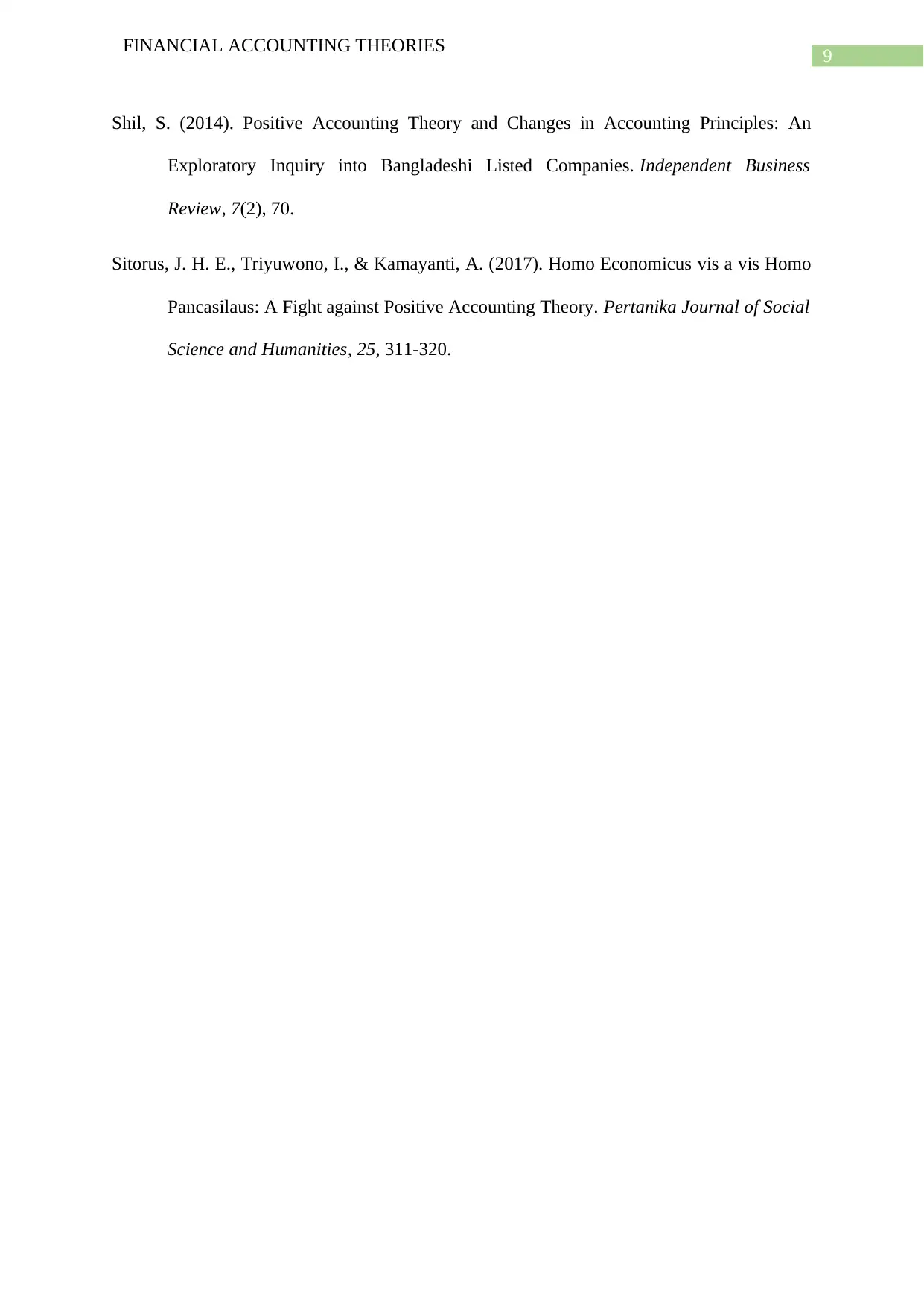
9
FINANCIAL ACCOUNTING THEORIES
Shil, S. (2014). Positive Accounting Theory and Changes in Accounting Principles: An
Exploratory Inquiry into Bangladeshi Listed Companies. Independent Business
Review, 7(2), 70.
Sitorus, J. H. E., Triyuwono, I., & Kamayanti, A. (2017). Homo Economicus vis a vis Homo
Pancasilaus: A Fight against Positive Accounting Theory. Pertanika Journal of Social
Science and Humanities, 25, 311-320.
FINANCIAL ACCOUNTING THEORIES
Shil, S. (2014). Positive Accounting Theory and Changes in Accounting Principles: An
Exploratory Inquiry into Bangladeshi Listed Companies. Independent Business
Review, 7(2), 70.
Sitorus, J. H. E., Triyuwono, I., & Kamayanti, A. (2017). Homo Economicus vis a vis Homo
Pancasilaus: A Fight against Positive Accounting Theory. Pertanika Journal of Social
Science and Humanities, 25, 311-320.
1 out of 10
Related Documents
Your All-in-One AI-Powered Toolkit for Academic Success.
+13062052269
info@desklib.com
Available 24*7 on WhatsApp / Email
![[object Object]](/_next/static/media/star-bottom.7253800d.svg)
Unlock your academic potential
Copyright © 2020–2025 A2Z Services. All Rights Reserved. Developed and managed by ZUCOL.





